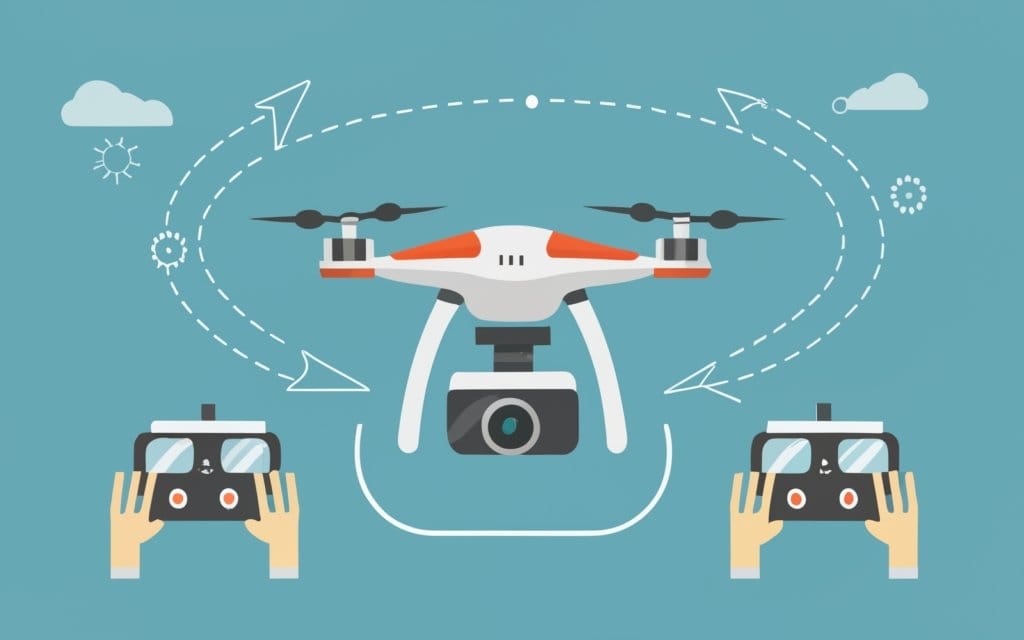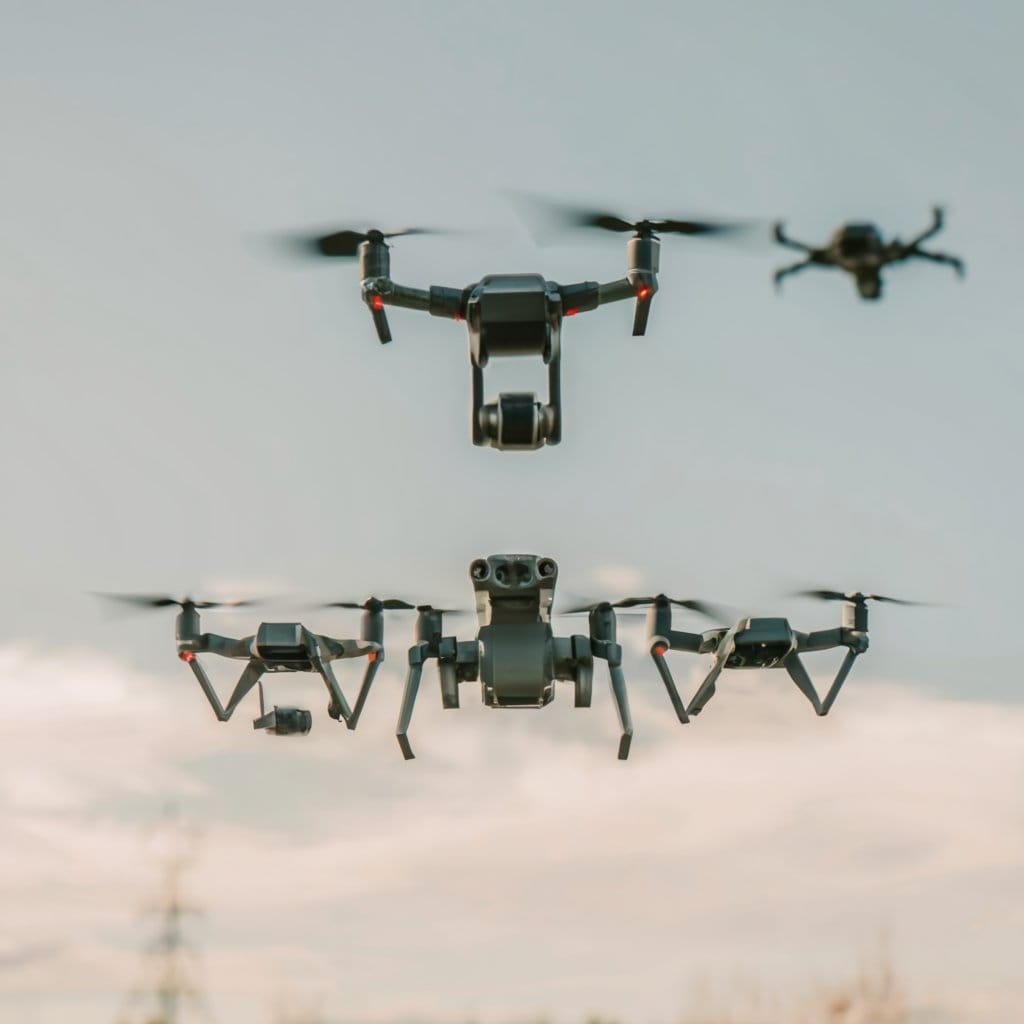Have you ever wondered how drones fly through the skies with such precision? Understanding the drone aerodynamics is crucial to comprehend how these unmanned aerial vehicles operate. You will gain a deeper insight into how drones can fly effortlessly as we will reveal the fundamental tenets of drone aerodynamics.
Join us on an exploration of the intricate dynamics that govern drone flight. From rotor blades generating lift to the role of propulsion systems in achieving stability, we will dissect each element contributing to the flying of drones. Get ready to uncover the science behind how drones fly and move with the help of rotors and navigation through our skies.

Aerodynamics of Drone Flight
Flight Forces
Drones fly through the interaction of four primary forces: lift, weight, thrust, and drag. The drone’s propellers or rotors generate lift by pushing air downwards, allowing it to fly. This movement creates angular momentum, enabling the drone to move in the right direction. This force allows the drone to fly by opposing the weight and using angular momentum from the rotors to move and ascend. Meanwhile, thrust, created by the propulsion system, counteracts drag caused by air resistance.
The balance between the rotors’ forces determines whether a drone moves right, ascends, descends, or maintains its altitude. For instance:
- When a drone increases its speed without changing its altitude, it increases thrust to overcome additional drag.
- The lift force must exceed the weight force if the drone needs to ascend.
- Descending involves reducing lift below weight while adjusting thrust and pitch angle.
Control Surfaces
Drone flight control surfaces include ailerons, elevators, and rudders that help manage movement along three axes: roll (side-to-side), pitch (up-and-down), and yaw (rotation). Ailerons control rolling movements; elevators control pitching; rudders adjust yawing. Some drones have flaps on the wings, which can be adjusted to enhance lift or increase drag in the takeoff and landing phases of drone flying.
Aerodynamic Moments
Aerodynamic moments refer to how drones fly and rotate around their center of gravity due to aerodynamic forces acting on them. These moments are crucial for controlling stability during flight. For example:
- Pitching moment occurs when changes in angle affect how much lift is produced at different parts of the wing or rotors.
- Yawing moment results from uneven airflow over vertical stabilizers, causing rotation around the vertical axis.
- The rolling moment happens when one side generates more lift than the other due to differences in airflow caused by the rotation of the rotors.
Propulsion Role
Propulsion systems power drones’ forward motion and maneuverability through throttle settings and rotor speed changes. The role of propulsion during drone flying includes:
- Enabling controlled takeoffs and landings by adjusting thrust output according to altitude requirements.
- Facilitating directional changes via adjustments in motor speeds corresponding to desired turns or maneuvers.
Drones’ Functional Principles
Working Mechanism
Drones fly by utilizing a combination of propellers and various sensors to maintain stability and control their movement. The propellers generate lift, allowing the drone to ascend, descend, or remain airborne. These propellers are powered by electric motors that receive commands from the drone’s flight controller.
The flight controller is essentially the drone’s brain, receiving input from the pilot or autopilot system and translating it into specific motor commands to adjust speed, direction, and altitude. This intricate coordination allows drones to navigate through different environments with precision.
Moreover, drones rely on gyroscopes, accelerometers, and magnetometers for orientation detection. Gyroscopes measure angular velocity, while accelerometers gauge linear acceleration. Magnetometers help determine orientation relative to Earth’s magnetic field. Drones can maintain stable flight even in challenging conditions such as solid winds by processing data from these sensors in real time.
Positioning Systems
GPS (Global Positioning System) enables autonomous flights where drones can follow pre-defined routes without constant human intervention. This technology leverages signals from satellites orbiting Earth to calculate the drone’s exact position accurately.
Furthermore, some advanced drones utilize additional positioning systems like GLONASS (Global Navigation Satellite System) or Galileo alongside GPS for improved reliability in various regions around the globe.
Another essential feature in many commercial drones is RTK (Real-Time Kinematic) positioning, which provides centimeter-level accuracy by using ground-based reference stations and satellite signals.
These sophisticated positioning systems ensure precise navigation and enable advanced functions such as surveying large areas with drones in mapping or executing complex inspection tasks autonomously.
Drone Components Explained
Drones are composed of several significant parts that work together to enable flight. The propellers generate the necessary lift for the drone to take off and stay airborne. They create a difference in air pressure above and below the rotor blades, allowing the drone to ascend. The motors power these propellers by converting electrical energy into mechanical energy, which drives their rotation.
Furthermore, drones contain a battery, serving as their primary power source. During flight operations, it supplies electricity to all essential components, such as motors, sensors, and communication systems. Drones have an onboard computer or flight controller responsible for interpreting commands from the pilot or autopilot system and adjusting motor speeds accordingly.
On the other hand, barometers assist in measuring altitude by gauging atmospheric pressure variations at different heights above sea level. GPS modules allow drones to determine their precise location coordinates through satellite signals, while magnetometers help detect magnetic field strength and direction, enabling accurate orientation determination even without GPS signals.
The frame is another crucial part of a drone; it provides structural support for mounting all other components while ensuring durability and stability during flight maneuvers.
Mastering Drone Operation
Flight Proficiency
Understanding how drones fly is crucial for mastering drone operations. A key aspect of flight proficiency involves comprehending the basic principles of aerodynamics. Drones generate lift through their propellers, which counteract the force of gravity to keep them airborne.
Aspiring drone pilots should familiarize themselves with thrust, drag, weight, and lift concepts to enhance flight proficiency. For instance, increasing the speed of the propellers results in greater thrust, which allows the drone to ascend or maintain altitude. Similarly, adjusting the angle of attack affects how air flows over the wings or rotors to produce lift.
Furthermore, gaining practical experience by flying drones in various weather conditions and environments can significantly improve flight skills. Pilots can practice controlling their drones at different altitudes and maneuvering through obstacles to understand better how drones fly in adverse conditions.
- Understanding aerodynamics
- Practicing control in diverse conditions
- Applying knowledge of thrust and lift
Precision Techniques
Precision techniques are pivotal in optimizing how drones fly during operations that require accuracy and finesse. One essential skill is maintaining stable hover capabilities when capturing aerial footage or performing inspections. This involves effectively utilizing pitch, roll, and yaw controls to keep the drone steady.
Moreover, mastering waypoint navigation enables precise positioning for tasks like mapping or surveying large areas efficiently. Setting accurate waypoints using GPS technology and leveraging features like the return-to-home function ensures precise navigation even without constant manual input from the pilot.
Understanding advanced flight modes such as “Point of Interest” or “Follow Me” empowers operators to execute complex maneuvers efficiently while ensuring precision in capturing specific subjects or accurately tracking moving objects.
- Utilizing pitch control for stable hover
- Mastering waypoint navigation for precision
- Leveraging advanced flight modes for accuracy
Combining fundamental knowledge about aerodynamics with hands-on experience in diverse flying conditions alongside honing precision techniques such as hovering stability and waypoint navigation mastery will enable aspiring drone pilots to master efficient drone operation.
Final Thoughts on How Drones Fly
In conclusion, understanding the aerodynamics and components of drones is crucial for mastering the flying operations of drones. By comprehending the functional principles behind drone flight, enthusiasts and professionals can optimize their usage and ensure safe and efficient operations. With this knowledge, you can harness the full potential of drones in various fields, from photography and videography to agriculture and search-and-rescue missions. Embracing continuous learning about drone technology will enhance your skills and contribute to the safe integration of drones into our airspace.




Pingback: 10 Best Drones for Kids 2024: Ultimate Buyer's Guide